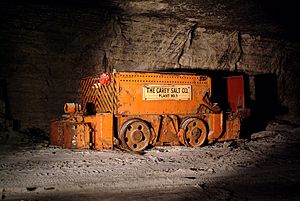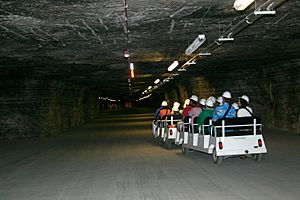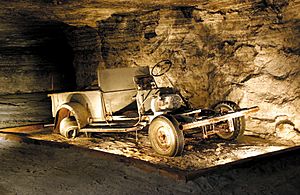Strataca facts for kids

Main Entrance (2022)
|
|
| Lua error in Module:Location_map at line 420: attempt to index field 'wikibase' (a nil value). | |
| Former name | Kansas Underground Salt Museum |
|---|---|
| Established | May 1, 2007 |
| Location | 3650 East Avenue G, Hutchinson, KS 67501 USA |
| Type | Salt mine |
Strataca is a special museum located deep inside a salt mine in Hutchinson, Kansas, United States. It used to be called the Kansas Underground Salt Museum. This museum is built within one of the biggest rock salt deposits on Earth. This salt formed about 275 million years ago!
At Strataca, you can go 650 feet (about 198 meters) underground. It's the only salt mine in the United States that tourists can visit. The museum is part of the Hutchinson Salt Company mine, which started operating in 1923.
Contents
Exploring Strataca: The Underground Salt Museum
How Salt is Mined
The Hutchinson Salt Company mine is huge, covering about 980 acres (almost 4 square kilometers) underground. If you lined up all the excavated areas, they would stretch for 150 miles (about 241 kilometers)! To keep the mine safe, large square pillars of solid rock salt, each 40 feet (about 12 meters) wide, are left in place to support the ceiling.
Since 1923, miners have used a method called "room and pillar" mining. This means they dig out large square rooms and leave square pillars of salt to hold up the ground above. This method also helps fresh air move through the mine.
Miners use explosives to break the salt into smaller pieces. These pieces are then moved to crushers and brought to the surface using large buckets on a hoist. This special elevator is called a "skip." A fully loaded skip can carry four tons of salt and makes a round trip every three minutes. This skip also transports miners up and down. Because this rock salt has some impurities like shale, it's mostly used for things like road salt (to melt ice on roads) or for feeding livestock.
Other companies, like Cargill Salt and Morton Salt, use a different method called "solution mining." They pump water down into the salt deposit, which dissolves the salt into a salty liquid called brine. This brine is then pumped to the surface and heated until the water evaporates, leaving behind a very pure salt. This purer salt is used for table salt, medicines, food, and chemicals.
Getting Around Underground
When you visit Strataca, you ride on electric trams with guides who tell you about the mine. Miners, however, use different vehicles. They use vehicles that run on biodiesel fuel, which is almost 100% cooking oil! After the mine's old rail system stopped being used, miners started using old cars modified to run on this special fuel. The Hutchinson Salt Company mine was the first mine in North America to switch its underground vehicles to B100 fuel.
Building the Museum Entrance
Before the museum opened, miners and visitors used a single elevator that could only hold ten people at a time. This elevator also carried salt, so salt production had to stop when people were going up or down. To make the museum possible, a new shaft (a deep hole for an elevator) had to be built. The museum worked with Underground Vaults & Storage, a storage company also located in the mine, to share the cost of this new shaft.
Building the new shaft was tricky because it had to go through a huge underground water source called an aquifer. To prevent water from leaking into the shaft, the ground around it was frozen solid! This allowed workers to dig through the frozen ground and line the shaft with concrete. This big project started in March 2004 and took almost a year to finish.
The Museum's Name Change
On June 4, 2013, the museum changed its name from the Kansas Underground Salt Museum to Strataca.
What You'll See at Strataca
It takes just 90 seconds to travel 650 feet (about 198 meters) down to the museum in a special double-deck elevator that holds fifteen people on each level.
The conditions underground are always the same. The mine stays at a comfortable 68 degrees Fahrenheit (20 degrees Celsius) with about 45% humidity. The mine rooms are very large, with ceilings ranging from 11 to 17 feet (about 3 to 5 meters) high. Since 1954, everyone entering the mine has had to wear a hard hat and carry a rescue breather, though no visitor or employee has ever needed to use the breather. The Mine Safety and Health Administration, which checks the mine regularly, considers it one of the safest in the world.
The flooring in much of the museum is made of a special material called Saltcrete. It's like concrete but uses salt instead of sand. Saltcrete can release a fine salt dust until it fully dries, which takes about a year. It can't be used where there's a lot of water because water makes it blister and break apart.
The Dark Ride
The Dark Ride is an exciting tram tour that takes you deeper into the mine, beyond the main museum area. You'll see different parts of the mine and even experience complete darkness for a moment. The tour also stops at a salt pile where you can fill a small bag with salt crystals to take home as a souvenir!
Mantrip Gallery
"Mantrips" are like train-like vehicles. In this gallery, you can see two of the mantrips that used to carry miners to and from their work areas. The rail system was used until the 1980s. After that, miners started using modified vehicles that run on B100 bio-diesel fuel. These vehicles are often old cars that were taken apart to fit down the mine shaft, then put back together underground with extra seats and safety bars.
Mining Gallery
This gallery teaches you all about how salt is mined, both in the past and today.
- Undercut and Drill Area: Here, you'll see how miners prepare for a blast. They use a machine to cut a slot at the bottom of the salt wall. Then, they drill holes into the wall where explosives will be placed.
- Blast Area: This part shows how the room is set up with explosives. You can see a "powder car," which was a modified drill that carried all the tools and explosives needed for a blast.
- Load Area: This section features a "Joy Loader," a large machine used from the 1940s until 1983. This machine made mining much faster because miners no longer had to load salt by hand. Like many large pieces of equipment, it was brought down the shaft in pieces and welded back together underground. Once equipment is underground, it's usually left there after it's no longer needed. You'll also see a "shuttle" that carried salt from the blast site to the main rail lines, making the process more efficient.
Geology Gallery
In this gallery, you'll learn about the salt bed in Kansas and how it formed. It focuses on the Permian Period, which was about 250 to 300 million years ago. You'll learn about the animals that lived during that time and why there are no animal fossils in the salt bed itself. Sometimes, tiny water bubbles are found trapped inside the salt. Scientists believe these "fluid inclusions" formed during the Permian Period.
One interesting exhibit features what some scientists claim is the world's oldest living organism, estimated to be about 250 million years old! This refers to bacteria found trapped inside a salt crystal. While the crystal is very old, DNA analysis suggests the bacteria themselves might be younger.
Underground Vaults & Storage Gallery
Underground Vaults & Storage (UV&S) is a highly secure storage facility located in another part of the salt mine that is not open to the public. However, the museum has a special gallery that shows what their operation looks like. UV&S is famous for storing important items like the original film negatives of many movies, including Gone with the Wind and Ben Hur, as well as master copies of TV shows. They also store medical records, oil and gas charts, and many other valuable documents and materials from all over the world.
UV&S and Strataca have borrowed several cool items and actual costumes from popular movies for temporary exhibits. These have included costumes like those worn by Batman and Mr. Freeze from Batman & Robin, James Dean’s shirt from Giant, the Snowman from the 1998 film Jack Frost, and Agent Smith’s costume from The Matrix.
See also
- List of museums in Kansas
- Cosmosphere, space museum, in Hutchinson






